Understanding how to do a website security scan is important for maintaining strong website security, safeguarding confidential data, and ensuring compliance with industry standards. A website security scan involves assessing your site for vulnerabilities, malware, and other threats that could compromise its security and data integrity. The scanning process can vary depending on whether the site uses a content management system (CMS) like WordPress or Joomla or is a custom-built website.
Here’s what you need to know about how to scan your website for vulnerabilities, common mistakes to avoid during the process, and the reliable tools you can use to enhance your website’s security. By conducting a site security scan, you can proactively address potential issues, avoid costly data recovery efforts, and mitigate legal liabilities after a breach.
KEY TAKEAWAYS
- •Website vulnerability scanning can help you spot common website vulnerabilities, including broken access control, security misconfiguration, unpatched components, and cross-site scripting vulnerabilities. (Jump to Section)
- •By following website security scanning best practices, you can accurately identify vulnerabilities and minimize risks of cyber attacks. (Jump to Section)
- •There are different types of website vulnerability scanning tools you can use for WordPress, Joomla, and custom websites. (Jump to Section)
Featured Partners: Vulnerability Management Software
How to Scan a WordPress Website for Vulnerabilities
WordPress is one of the most popular content management systems in the world, holding 62.5 percent of the global CMS market share. Its flexibility, ease of use, and extensive library of plugins and themes make it a preferred choice for developers and users alike. However, this popularity also makes WordPress a target for hackers and cybercriminals. Fortunately, scanning your WordPress website for vulnerabilities is a straightforward process.
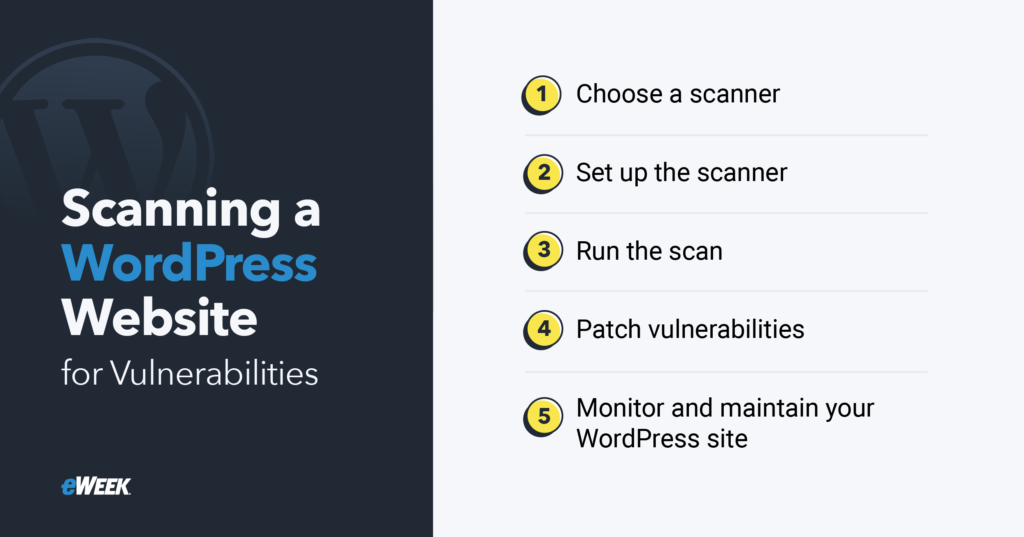
1. Choose a Scanner
Choose a suitable scanner—you can opt for plugins like Wordfence or WPScan, which are specifically designed for WordPress security, or consider a more comprehensive commercial tool like Acunetix or MalCare Security Plugin.
2. Set Up the Scanner
If you are using a plugin, you need to install and configure it to scan your site. For online tools like WPScan, visit the provider’s website and follow the instructions. Commercial scanners typically require you to sign up for the service and configure the settings for your site.
3. Run the Scan
Schedule the plugin to scan your site at regular intervals; it will send scan results via email alerts. For online scanners, input your site’s URL into the tool’s webpage and wait for the scan to complete. Most commercial tools let you schedule scans according to their settings.
4. Patch Vulnerabilities
Address vulnerabilities based on the scan results. If using a plugin scanner, regularly update your WordPress core, themes, and plugins, and apply any recommended patches. For commercial scanning tools, follow instructions for patching vulnerabilities. Regardless of the scanner type, ensure that all necessary patches are applied to maintain your site’s security.
5. Monitor and Maintain the Site
To maintain the security of your WordPress site, regular monitoring and upkeep are needed. Periodically conduct scans to detect emerging vulnerabilities and routinely check for security issues to effectively secure the online presence of your website.
How to Scan a Joomla Website for Vulnerabilities
While not as widely used as WordPress, Joomla is still another popular CMS with more than 123 million downloads worldwide. This free CMS is renowned for its ease of use, flexibility, and powerful core features, making it a prime target for hackers and cybercriminals. To minimize risks, follow a systematic approach when scanning Joomla websites for vulnerabilities.
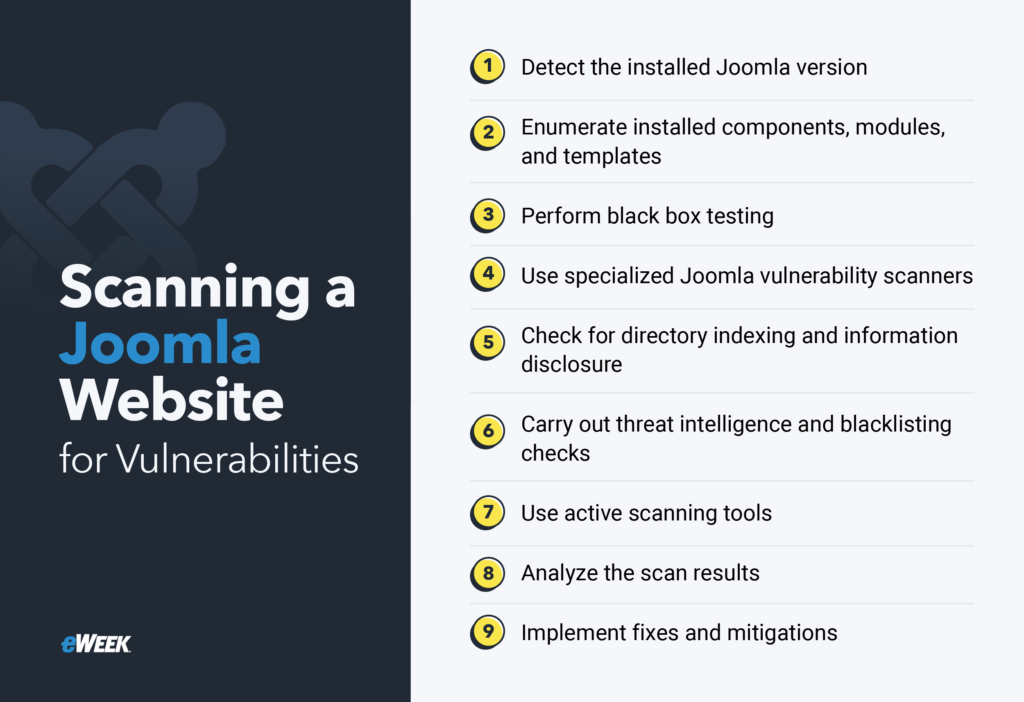

1. Detect the Installed Joomla Version
Determine the exact version of Joomla running on the target site. This is an important step as it helps in uncovering vulnerabilities specific to that particular version. By identifying the installed version, you can cross-reference it against security databases for any potential security flaws that may be present in the website.
2. Enumerate Installed Components, Modules, and Templates
Then, list all installed components, modules, and templates on the website. These extensions can introduce additional vulnerabilities beyond those present in the core Joomla software. Tools like JoomScan can enumerate common information about the Joomla site, including the version number, CVEs, firewall detection, and common logs.
3. Perform Black-Box Testing
Black-box testing is a technique used to simulate an external attacker attempting to gain unauthorized access to the Joomla website. You treat the website as a black box, without any prior knowledge of its internal workings or configuration. Try to find security weaknesses by interacting with the website in the same way a malicious actor would—by submitting malformed input, exploiting common vulnerabilities, and probing for sensitive information.
4. Use Specialized Joomla Vulnerability Scanners
Use specialized Joomla vulnerability scanners and security tools to automate the detection of known vulnerabilities, misconfigurations, and entry points for attacks. By running these scanners against the website, you can quickly unveil areas of concern and prioritize remediation efforts.
5. Check for Directory Indexing and Information Disclosure
Complete a passive scan to check if directory indexing is enabled on key locations. This can reveal sensitive information like source code, configuration files, and database dumps that could aid an attacker. Additionally, look for pages that disclose sensitive information in their HTML comments or in linked JavaScript files.
6. Carry out Threat Intelligence and Blacklisting Checks
Vulnerability scanners like JoomlaVS can check if the site is linked from pages known to host malware or be associated with spam. Verify if the site’s IP address or domain is blacklisted by security organizations or antivirus vendors.
7. Use Active Scanning Tools
Free scanners like OpenVAS can help expose known vulnerabilities in Joomla core, themes, extensions, modules, and components. By using these active tools, you can locate security weaknesses that may not be immediately apparent through passive analysis alone.
8. Analyze the Results
Review detailed reports to pinpoint high-risk vulnerabilities that could allow an attacker to gain unauthorized access, elevate privileges, or compromise sensitive data. Prioritize remediation based on factors like exploit availability, impact, and ease of exploitation.
9. Implement Fixes and Mitigations
Update Joomla core and extensions to the latest secure versions to patch known vulnerabilities. Implement strong access controls, password policies, and multi-factor authentication (MFA) to limit unauthorized access. Configure web application firewalls (WAFs) and intrusion detection systems (IDS) to protect against common attacks.
How to Scan a Custom-Built Website for Vulnerabilities
Custom-built websites can be particularly vulnerable to security threats, as they often lack the robust security features and regular updates found in modern content management systems. These sites require a more manual and creative means to vulnerability scanning. By following a structured approach, combining automated and manual techniques, and staying current with security best practices, you can scan your custom website for vulnerabilities and help boost its defense.
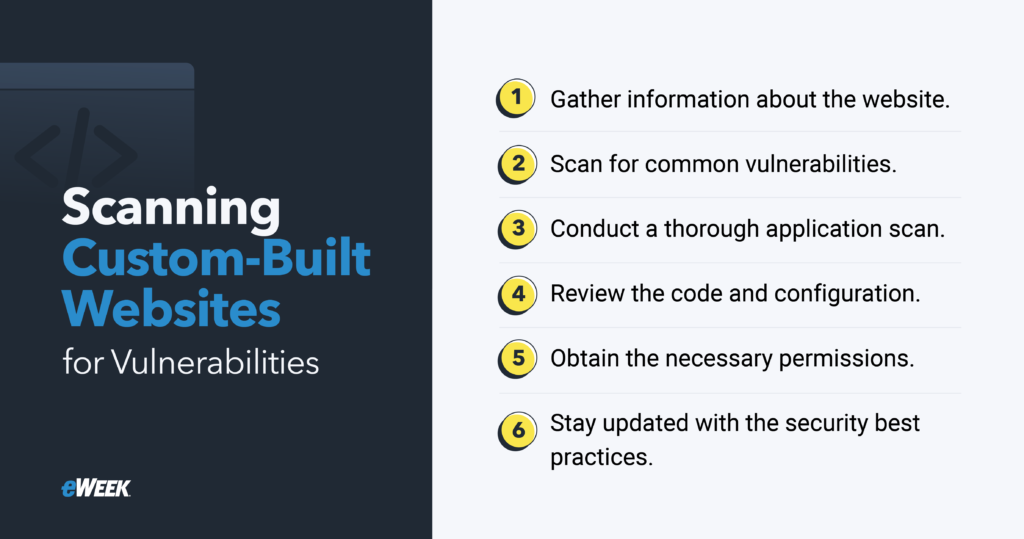

1. Gather Information
Start by using a web scanning tool like WhatWeb to gather information about the website, including programming languages, frameworks, and versions used. This information can help you pinpoint known vulnerabilities that may affect the site. Look for outdated versions of components with known exploits available. Determining the programming versions can also give clues, as new vulnerabilities are constantly being discovered.
2. Scan for Common Vulnerabilities
Use security scanners like ZAP, w3af, and skipfish to check for usual web server and application vulnerabilities. These scanners can reveal obsolete system components, configuration errors, and weak access points, giving you a good baseline understanding of your website’s security status.
3. Conduct a Thorough Application Scan
For a deeper scanning of your web application, consider a more advanced solution like Burp Scanner. This web vulnerability scanner can help you locate typical website vulnerabilities and other application-specific weaknesses. Sophisticated website scanners can test for more complex vulnerabilities and offer more in-depth security analysis.
4. Review the Code and Configuration
Conducting a hands-on security audit and manually reviewing the code, configuration files, and server logs can help reveal vulnerabilities that automated scanners may miss. Search for improper input validation, weak authentication, and other insecure coding practices. Looking for misconfigurations and unnecessary services is also important.
5. Obtain Necessary Permissions
Remember to always have permission before conducting any penetration testing activities on a website you do not own or manage. Unauthorized testing can be considered illegal in some jurisdictions, so ensure you have explicit authorization and follow any rules of engagement.
6. Stay Up-to-Date with Security Best Practices
Continuously stay informed about the latest security best practices and vulnerabilities to ensure your scanning methodology is effective and up-to-date. Follow security pages and join online communities to keep up with the latest cyberthreats and website vulnerabilities, then update your scanning procedures to account for threats and techniques.
10 Common Website Vulnerabilities
Websites are common targets for malicious actors because of the sensitive data they handle. Failing to resolve obvious website vulnerabilities can lead to devastating consequences, like data breaches, system compromises, and reputational damage. Website vulnerabilities scanners can help detect some of the most common website vulnerabilities, including the following:
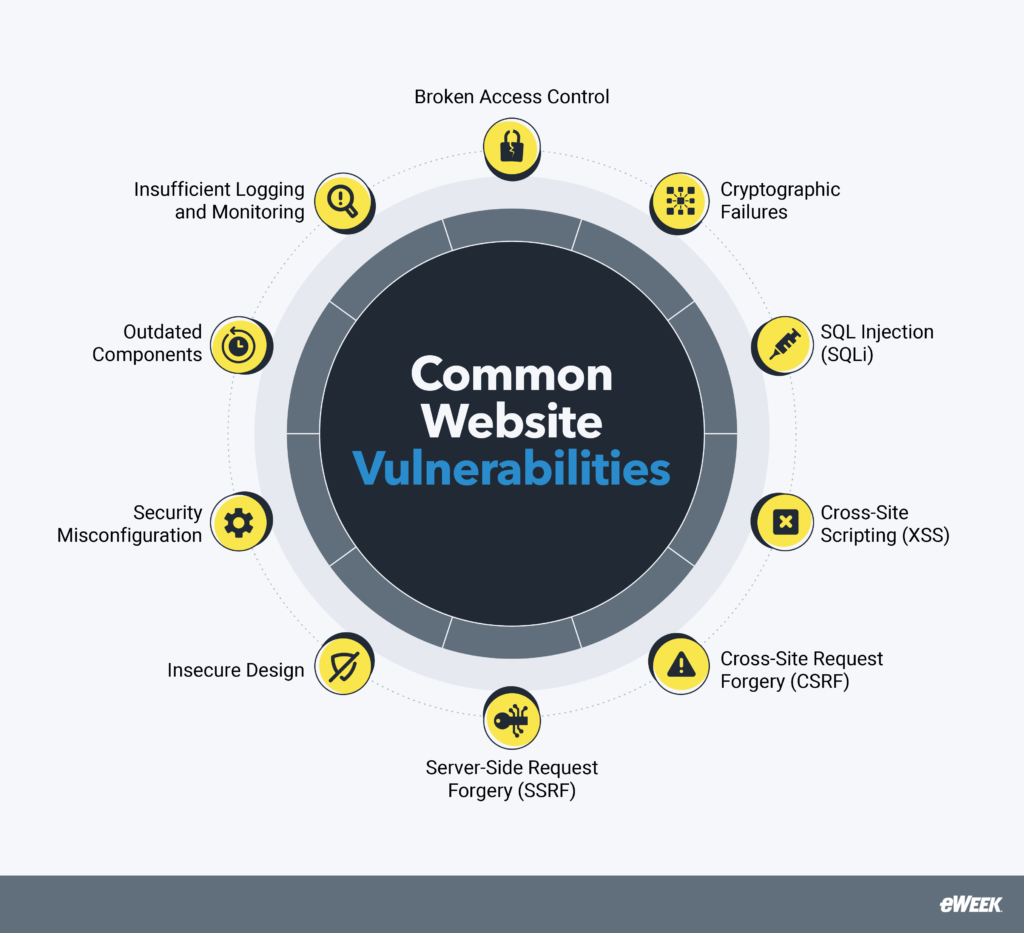

- Broken Access Control: This happens when security restrictions are not properly enforced, often due to inadequate role-based access controls or insufficient validation of user permissions. As a result, an attacker gains unauthorized access to sensitive data or functions.
- Cryptographic Failures: Formerly known as sensitive data exposure, cryptographic failures expose sensitive information through weak encryption, improper key management, or insecure data storage. Attackers can exploit these vulnerabilities to intercept passwords, financial information, or personal data.
- SQL Injection (SQLi): This vulnerability involves an attacker injecting malicious SQL code into web application input fields, such as login forms or search bars. If successful, they can access, modify, or delete data stored in the backend database, which may lead to data breaches.
- Cross-Site Scripting (XSS): XSS vulnerabilities allow attackers to inject malicious scripts into a web application’s output, oftentimes by taking advantage of insecure user input handling. When executed in a victim’s browser, these scripts can hijack user sessions, deface websites, or redirect you to malicious sites. XSS is particularly dangerous for eCommerce and banking sites that handle sensitive financial information.
- Cross-Site Request Forgery (CSRF): CSRF attacks trick you into doing unintended actions, like changing your password or transferring funds, on a web application you’re already authenticated with. Attackers achieve this by embedding malicious code on a website or by sending a crafted link via email or instant message.
- Server-Side Request Forgery (SSRF): SSRF exploits a server’s ability to send requests to other systems. Attackers use this to access internal resources, steal sensitive data, or launch further attacks within a network.
- Insecure Design: This vulnerability results from failing to incorporate proper security during the web application’s development phase. Poor design choices, such as missing authentication layers or unchecked input validation, leave websites vulnerable to exploitation.
- Security Misconfiguration: Default settings, excessive permissions, or unnecessary features in a web application can create entry points for attackers. This could lead to unauthorized access, data breaches, or service disruptions.
- Outdated Components: Using old libraries, plugins, or software dependencies increases the risk of exploitation due to unpatched vulnerabilities. Outdated components often lack the latest security patches, enabling attackers to compromise the system or inject malicious code.
- Insufficient Logging and Monitoring: Without effective tracking and alerts, suspicious activities go unnoticed, allowing breaches to persist and possibly escalate. This could delay the identification of threats, increasing the risk of data loss and prolonged downtime.
Best Practices for Website Security Scanning
According to the World Economic Forum, damages incurred by cybercrime could reach $10.5 trillion annually by 2025. Adopting best practices for website security scanning can boost your defense against cyber threats. These practices establish a strong foundation for maintaining a secure and resilient infrastructure.
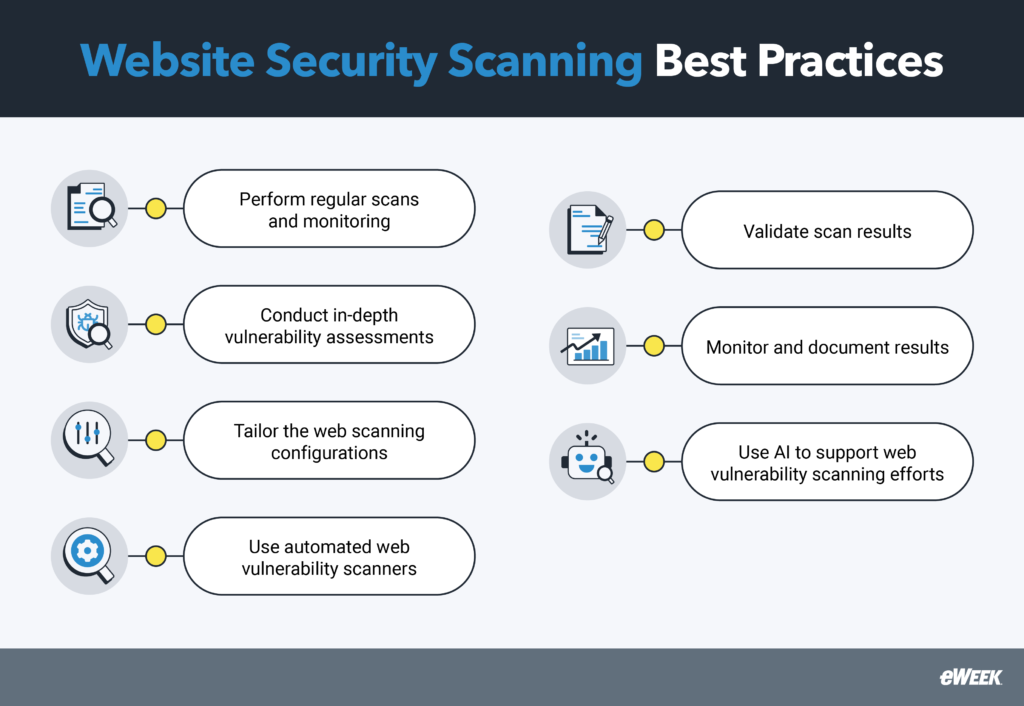

- Conduct Regular Scans and Monitoring: Schedule frequent scans to detect new vulnerabilities as they arise. Routine checks ensure risks from updates, new features, or configuration changes are promptly resolved. Complement scans with real-time monitoring tools to detect unusual activity or breaches quickly.
- Ensure In-Depth Vulnerability Assessments: Perform scans that cover all aspects of your website, including databases, APIs, and third-party integrations. Don’t overlook hidden files, misconfigured permissions, or outdated libraries that can create entry points for attackers.
- Customize Scanning Configurations: Configure scanning tools to align with your website’s specific structure. Generic scans may miss vulnerabilities unique to your site’s setup, and customizing the scan increases accuracy.
- Use Automated Scanning Tools: Integrate automated scanning tools to spot issues faster and more consistently. These tools can be scheduled to run periodically or triggered after major site quotes, reducing the risk of human error and improving efficiency in uncovering vulnerabilities.
- Validate and Cross-Check Results: While automated scanning tools are effective, they are not infallible, so don’t assume that all scan results are completely accurate. Manually verify detected vulnerabilities to rule out false positives or negatives–this way you can dedicate remediation efforts on actual risks.
- Track and Document Scanning Results: Maintain detailed records of each scan, including detected vulnerabilities, their severity, and actions taken. A clear record helps find recurring issues and promotes accountability in mitigating risks.
- Use AI to Boost Scanning: Incorporate artificial intelligence (AI) technologies like AI security software to automate vulnerability detection and real-time threat analysis. Consider applying generative AI for cybersecurity to simulate attack scenarios and predict potential risks.
Top 3 Website Security Scanning Tools to Consider
Choosing the right website security scanner plays a substantial role in keeping your online presence secure. Here are some of the top website scanning tools for WordPress, Joomla, and custom-built sites to help you detect vulnerabilities, monitor potential threats, and strengthen your website’s security posture.


WPScan
WPScan is a popular security scanner designed to assess the security of WordPress websites. Its key strengths include vulnerability detection, version enumeration, and user enumeration capabilities. This website vulnerability scanning tool can check the WordPress core, plugins, and themes against a large database of known vulnerabilities, so you can quickly deal with security issues that may arise. WPScan also delivers password brute-force testing and detects publicly accessible configuration files and database dumps.
WPScan requires a paid API subscription to access the full vulnerability database and receive detailed vulnerability information. However, the free API plan should be sufficient for many WordPress users, and the tool’s extensive security scanning capabilities make it a valuable choice for securing WordPress websites.


JoomScan
JoomScan is an open-source vulnerability scanner project under OWASP and is a reputable tool for detecting and analyzing vulnerabilities in Joomla installations. JoomScan can perform in-depth scans of Joomla sites, enumerate versions, detect core vulnerabilities, identify installed components/modules, and find directory listings and backup files. In addition, its modular and lightweight architecture ensures minimal footprint during scans.
While JoomScan brings valuable features, it has limited documentation and project updates, which may impact long-term viability against new Joomla vulnerabilities. However, as an open-source project, the community can contribute to tackle any shortcomings.


Astra Vulnerability Scanner
Astra is a comprehensive website security scanning tool that covers over 9300 tests, detecting common security issues, like SQL injection and cross site scripting (XSS). It provides real-time monitoring and alerts to keep you informed about emerging threats, as well as detailed reports to support remediation efforts. One of Astra’s best features is its focus on minimizing false positives through automated scans verified by security experts. It’s worth noting, though, that while Astra offers advanced features, some users find its interface confusing.
Astra’s vulnerability scanner is priced at $199 per month, which can be used by five team members.
Frequently Asked Questions (FAQs)
You should scan for vulnerabilities at least quarterly. More frequent scans, such as monthly or even weekly, are recommended, especially for key systems or after significant changes to the IT environment. Continuous monitoring and scanning help you quickly spot and mitigate vulnerabilities, reducing the risk of exploitation.
Website vulnerability management is the process of finding and fixing security weaknesses to protect your site from potential threats. It involves regularly scanning for vulnerabilities, assessing their impact, and addressing the most serious issues first to keep your site secure and resilient.
Clicking on an insecure website can expose you to various risks, including malware infections, phishing attacks, or data theft. These websites may lack encryption, allowing attackers to intercept sensitive information, like passwords or payment details. In some cases, simply visiting the site could trigger harmful downloads or compromise your device.
Conclusion: Protecting Your Website With Regular Security Scans
By routinely scanning your website for vulnerabilities, you can swiftly find signs of security issues and take action. While automated scanning tools can be useful in detecting common vulnerabilities, they may not catch everything. These tools should be used in conjunction with manual code reviews.
Choose a reliable and trusted vulnerability scanning tool that can accurately identify vulnerabilities without generating an excessive number of false positives. You can take it a step further by using AI security software and generative AI for cybersecurity to build a stronger defense against cyberattacks.
Discover effective ways to fortify your cloud security and protect your organization by checking out our article on How to Guard Against the Biggest Cloud Security Threats.


